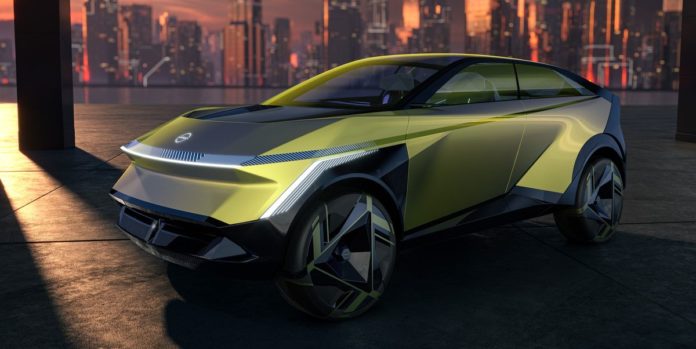- Nissan has shown the Hyper Urban concept ahead of its in-person debut at this month’s Japan Mobility Show in Tokyo.
- The electric concept is a small, sporty crossover with a sharp, angular design, with the triangular shapes drawing inspiration from kaleidoscopes.
- The cabin is just as crazy as the bodywork, with green LED accents and seats that can fold together to create a spacious lounge.
Nissan isn’t new to the EV business—the pioneering Leaf hatchback, which went on sale way back in 2011 with a paltry 73-mile range, paved the way for the deluge of electric vehicles now arriving on the market. Among those is Nissan’s Ariya SUV, which registered 5195 sales through the first half of this year. Now Nissan is giving us a taste of what to expect from the styling of its future electric cars with the very angular-looking Hyper Urban concept.
The squat, sporty crossover is one of several concepts Nissan will unveil before the Japan Mobility Show in Tokyo at the end of this month. Each will use the word “hyper” in its name to, according to the automaker, “express the heightened excitement they aim to bring.” The Hyper Urban’s bodywork is full of aggressive and dramatic slashes as if the designer had attacked a lump of clay with a sword to create the concept’s shape. The sharply sloping roofline, ginormous wheels, and stocky stance make the Hyper Urban look even more assertive.
The concept follows current design trends with full-width light bars and the front and rear, each with an intricate appearance comprised of receptive LED strips. The front and rear scissor doors theatrically open skyward to reveal a cabin that is just as angular as the exterior, full of triangular shapes—inspired by kaleidoscopes, Nissan says—green LED lighting and a yoke-style steering wheel. The front seats can collapse and fold into the rear seats to create a more spacious, lounge-like interior space.
Nissan didn’t go into detail regarding the powertrain, but the Hyper Urban is, of course, electric. Nissan imagines that the concept could provide power back into your home to reduce strain on the grid and save owners money. Nissan also mentioned a charging setup that is powered by artificial intelligence and can autonomously charge the crossover but didn’t provide specifics on how this would work. Ultimately, however, the powertrain specifics are of little consequence, and the Hyper Urban serves as a flight of fancy that previews Nissan’s future design direction. Just don’t expect the scissor doors to reach production.
This content is imported from poll. You may be able to find the same content in another format, or you may be able to find more information, at their web site.
Associate News Editor
Caleb Miller began blogging about cars at 13 years old, and he realized his dream of writing for a car magazine after graduating from Carnegie Mellon University and joining the Car and Driver team. He loves quirky and obscure autos, aiming to one day own something bizarre like a Nissan S-Cargo, and is an avid motorsports fan.


